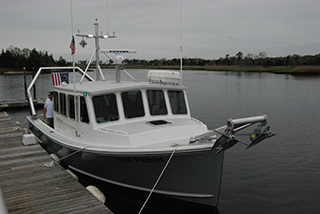Stockton University’s marine science station got its start years ago on a New Jersey waterfront lot near a Chinese restaurant. From this nondescript location, professors and students set out in 14’ Starcraft aluminum skiffs to study life in the winding tidal creeks and back bays close to Atlantic City.
On Wednesday, university officials dedicated the new flagship vessel of their marine field station. With its beamy Calvin Beal Jr.-designed hull and shallow draft, the new 36’x13’9”x4’ research vessel Petrel is as “equally at home on our river as it is 20 miles offshore,” said station manager Steve Evert.
The fiberglass vessel was built by SW Boatworks, Lemoine, Maine, where owner Stewart Workman and his wife Alice had acquired the Calvin Beal molds in 2008.
“Steve is familiar with the Calvin Beal boats because he’s fished off them, so he contacted us,” Stewart Workman said. The Workmans prepared specs and a proposal to be ready when Stockton went out for bids.
The 36’ design is a popular lobster boat, with “speed, stability, space,” Workman said. The company has branched out to building Beal hulls as sportfishing and utility boats – the Maine Marine Patrol christened its 38’9”x15’ patrol vessel Dirigo II from SW Boatworks in January 2014. But Stockton was the first customer for a research vessel.
After delivery in late 2015, Jersey Cape Yachts, Lower Bank, N.J., completed fitting out the boat and Patriot Marine Fabricating, Forked River, N.J. finished the hydraulics, Evert said. In April, the Petrel got underway, conducting a side scan sonar and bathymetry study in the Mullica River, near the university’s Port Republic field station.
 Inside the Petrel's wheelhouse. Kirk Moore photo.Propulsion from a Cummins QSC 8.3 diesel turning 550 hp through a Twin Disc marine gear at 2:1 reduction gives a service speed of 18 to 19 knots, with 400 gals. fuel. It is a step up in power because “we needed that, sometimes we only have a four-hour window” for tide and wind, Evert said.
Inside the Petrel's wheelhouse. Kirk Moore photo.Propulsion from a Cummins QSC 8.3 diesel turning 550 hp through a Twin Disc marine gear at 2:1 reduction gives a service speed of 18 to 19 knots, with 400 gals. fuel. It is a step up in power because “we needed that, sometimes we only have a four-hour window” for tide and wind, Evert said.
An A-frame with 1,000 lbs. capacity is used to deploy survey gear and oyster cages off the open transom, while on the port side a retractable arm deploys and EdgeTech 6205 bathymetric and side scan sonar unit. A Westerbeke generator provides ship’s power.
Inside the house, two consoles with separate networked instrumentation are set up for navigation and survey work. A Furuno NavNet suite with radar, chartplotter and color sounder are at the helm. The deck and overhead are built with sound dampening, and there is plenty of seating and standing room for students.
“This is a classroom right here,” Evert said.
“They have a really nice boat here,” Workman said. “This is going to serve them very well.”





